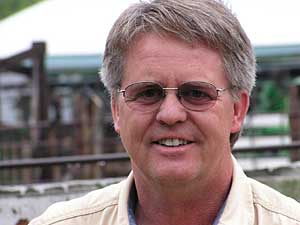|
Photos
More from MPR
Resources
|
May 26, 2005
 |
| Craig Lichtsinn wants to build the largest livestock feedlot in Minnesota. (MPR photo/Dan Gunderson) |
Wheaton, Minn. — Craig Lichtsinn grew up on a farm near the small Traverse County town of Dumont, Minnesota. He took over the farm from his dad, and he wants his son to have the same opportunity. But he says that won't happen unless his farm gets much larger.
So, Lichtsinn is joining forces with the largest dairy operator in the state to build what may be the state's largest livestock feedlot.
The initial plan was to house 14,000 heifers in three barns that would each be 210 feet by 1,200 feet. Lichtsinn says that plan may be downsized to 9,000 heifers, and two barns.
The young cows would be fed until they are old enough to begin milking. Then they would be moved to one of several dairy operations.
Each barn would be built over a 13-foot deep concrete pit. The pits would hold several million gallons of manure, which would be emptied once a year. The liquid manure would be injected into nearby farm fields.
Lichtsinn says he's getting on board with what he sees as the future of agriculture.
"Change is going to come. Do we want to have something that will help keep some people here? Or 10 years from now, if we lose the government programs and the small farmers get gobbled up by the big farmers, who's going to be left?" says Lichtsinn. "I don't know if I'll be here in 10 years if I we don't do something to grow. If you don't grow, you might as well quit."
The debate over livestock feedlots isn't new, but neighbors believe the massive size of this operation would create a whole new set of concerns. Tammy Conroy, her husband Mike, and their children live about a half mile from the proposed feedlot. "There's water contamination, there's air pollution, children with chronic illnesses, women having miscarriages, all kinds of undesireable effects," says Conroy. "We don't want to put our children and ourselves in the way of that."
At this point there are no clear answers to environmental concerns, because an environmental assessment worksheet for the project hasn't been completed.
Minnesota officials say the company financing this project has a good track record in the state. The Fehr family operates several large dairies in west central Minnesota, including one with more than 5,000 cows.
A Minnesota Pollution Control Agency spokesman says he can't comment on the proposed Traverse County feedlot because no permit applications have been filed with the state, but he says MPCA has received no complaints about other dairy operations run by the Fehr family.
Mike Conroy says he's visited one of the Fehr dairy farms and was impressed with the clean, efficient operation. But that didn't change his opposition to having a feedlot next door.
"There's going to be odor, there's going to be noxious gas, there's going to be dust -- and there's potential for much worse things. Like groundwater contamination, there's so many things. I just don't want to live as a guinea pig," says Conroy.
There are more than a dozen farms within three miles of the feedlot site, and neighbors say this project might be more palatable if it was in a remote area of the county where there are no homes for several miles.
Craig Lichtsinn says he has a right to expand his family farm, and he bristles at the thought he's willing to risk public health and the environment to make more money. He says he's set aside land for waterfowl habitat and put some of his land in the Conservation Reserve Program.
"The environment is very important to me. We have a lot of CRP. I've planted a lot of trees and food plots," says Lichtsinn. "I would never bring something into the community I thought would harm the environment."
But some of the neighbors say they no longer trust Lichtsinn. They claim he misled them about how many cows he planned to bring in.
In the past couple of months his feedlot proposal has turned neighbor against neighbor, and divided families around Wheaton.
The Traverse County planning commission is stuck in the middle of the dispute. Commission Chair John Roeschlein says the planning commission has never handled such a big project proposal. He says some local residents think the project is already a done deal, but he intends to give this project close scrutiny.
"The commission's job is to make sure all the facts are there, and all the rumors are dispelled, and all the concerns are addressed before we make a decision and make a recommendation to the county board," says Roeschlein. The project needs approval from the Traverse County board and the Minnesota Pollution Control Agency before construction can begin.
State and county officials say it's too early to say what level of environmental study will be required for the project.
The Traverse County Planning Commission expects to make a recommendation on the project by late summer.




